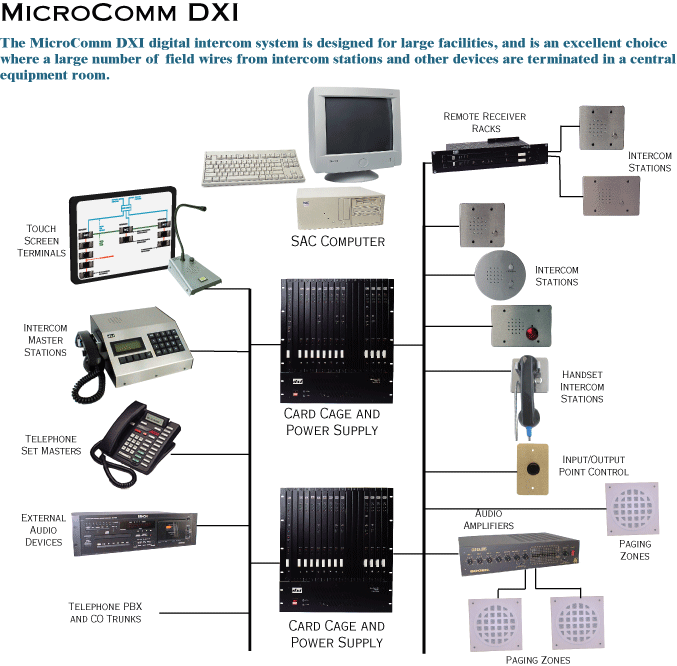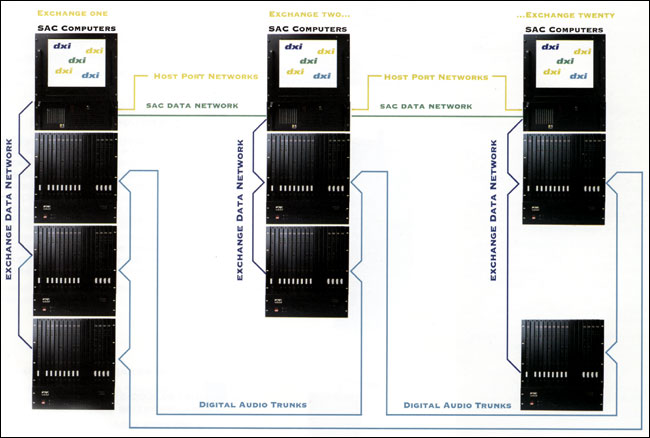
| MICROCOMM DXI |

The MicroComm DXI digital intercom system is specifically designed to meet the rigorous demands of correctional, industrial and high security applications. Its proven performance and reliability in a large number of facilities throughout North America makes it the number one choice of many design professionals, system contractors, and facility owners.
The MicroComm DXI’s digital technology provides high performance and a large feature set at a competitive price. It employs a flexible, distributed architecture that reduces wiring and minimizes the cost of installation.
Clear, crisp and intelligible communications can be coupled with functions such as audio level alarm detection and discrete audio monitoring to provide a powerful communications system. Its software-
based configuration ensures the MicroComm DXI is flexible enough to meet your future operational needs.
 Rugged construction, fault tolerant design, and comprehensive diagnostics make the MicroComm DXI easy to install and maintain. Its ability to be expanded on-line simplifies the coordination of phased construction and facility renovations.
Rugged construction, fault tolerant design, and comprehensive diagnostics make the MicroComm DXI easy to install and maintain. Its ability to be expanded on-line simplifies the coordination of phased construction and facility renovations.
Integration to touch screen terminals, graphic control panels, and host port computer systems is available through a variety of dedicated interfaces. Simple command messaging allows full external control of virtually all MicroComm DXI functions w ithout having to filter out extraneous communications.
Factory training programs covering all aspects of system design, installation, and maintenance are offered regularly to support MicroComm DXI dealers. Harding Instruments’ technical services division also provides ongoing assistance to ensure system applications proceed as smoothly as possible.
KEY FEATURES
Performance
- Digital audio signal processing and switching
- Clear, crisp audio for superior intelligibility
- Zero call blocking master station operation
- Video visitation intercom functions
- Audio level alarm with time controlled parameters
- Sequential and simultaneous audio monitoring
- Pre-recorded announcement distribution
- Programmable tones and event signaling
- Unlimited size of paging and program zones
Operation
- Simple touch screen terminal command interface
- Full system control through host computer
- Individual volume settings for each intercom station
- Multiple master station groups
- Alphanumeric descriptions for all devices
- Text labeled master station menu keys
- Multiple priority levels for all devices
- Unit unmanned and timeout call forwarding
Architecture
- Flexible, distributed exchange architecture
- Multiplexed audio and data trunks
- Fiber optic trunk options
- Reduced station wiring
- Wide variety of intercom and master stations
- Specialty intercom stations available
- Audio interfaces to external devices
- Telephone set interfaces
- Telephone line interfaces
- Two-way radio interface
- Supervised contact monitoring
- Solid state and relay output control
Reliability and Maintenance
- Rugged, reliable, fault tolerant design
- Redundancy options for key components
- Hot swappable components
- Comprehensive fault detection and diagnostics
- Built-in troubleshooting features
- On-line factory support and upgrades
- Activity logging
DEVICE BLOCK DIAGRAM
| SAC Computers – control the functions of each exchange and can be configured for redundant hot standby operation.Card cages – have seventeen slots available for audio control and device interface cards.Power Supplies – can be either standard or N+1 redundant format for card cages. Smaller power supplies are used for remote receiver racks and intercom master stations.Remote Receiver Racks – facilitate the installation of an audio interface board at a location requiring only a limited number of devices. They are available for both copper and fiber optic wiring.Touch Screen Terminals – similar host computers, and graphic panels can control virtually all MicroComm DXI functions through host port networks.Intercom master stations – for desktop, flush panel, and flush wall mounting are available with standard or large size alphanumeric displays and include various handset, headphone, and press-to-talk options. |
Telephone Set Masters – provide master station and administrative intercom functionality. Any CO trunk compatible telephone, including call display and cordless devices, can be used.Intercom Stations – come in a wide variety of styles that combine various faceplate, switch type and other features. Specialty intercom stations are also available.Handset Intercom Stations – can be used for visitation functions and in areas requiring conversation privacy.External Audio Devices – such as paging microphones, program sources, and call recorders can also be employed.Paging Zones – can be driven from the MicroComm DXI paging amplifier boards or standard audio power amplifiers. DXI talkback amplifier boards permit two-way communication with small zones.Input/Output Point Control – includes supervised contact monitoring as well as solid state and relay formats. |

SYSTEM BLOCK DIAGRAM
| Exchanges – can include up to 10 card cages located in proximity or remotely from each other. A MicroComm DXI system can include up to 20 exchanges.Digital Audio Trunks – interconnect every card cage in a MicroComm DXI system for universal call routing and audio distribution. |
Exchange Data Networks – communicate call request, alarm, keypad, display, connection and other internal messages.SAC Data Networks – provide high- speed data communications among exchanges and between redundant SAC computers.Host Port Networks – for external system control are available in a variety of formats, including ethernet neand serial port, for external system control. |

